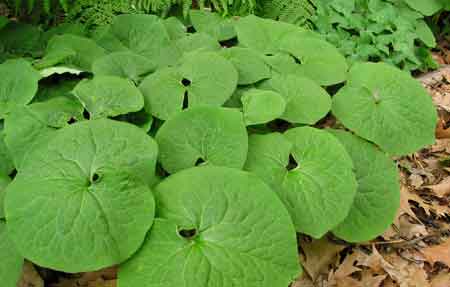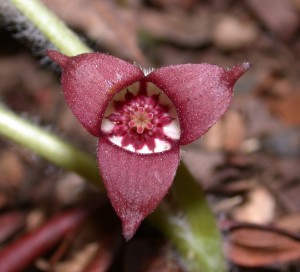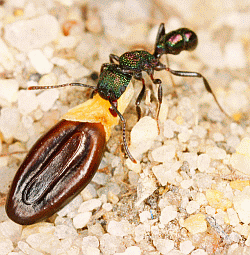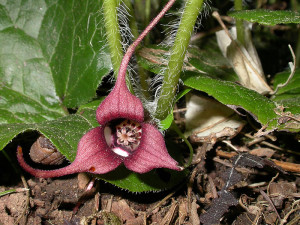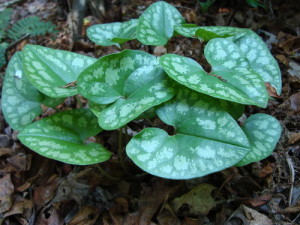Wild Ginger is cantharophilic, sometimes myophilic or sapromyophilic.
If that’s all Greek to you it should be because it is Greek bastardized via Dead Latin into English. Canthrarophilic means pollinated by beetles, myophilic or sapromyophilic pollinated by flies. I suspect bees (melittophily) occasionally get in there as well. Wild Ginger grows close to the ground so the beetle has a chance. The plant is also myrmecochoric meaning its seeds are disbursed by ants. We are told 11,532 species of angiosperms have seeds disbursed by ants. Busy little beavers they are. An explanation:
Seeds that are spread by ants usually have a fatty appendage or attachment called an elaiosome, which the Wild Ginger seed has. It looks tasty to an ant so the ant carries the entire seed back to the nest. Then it detaches or eats the elaisome, or figures out the appendage is not edible and dumps the seed outside the nest. Ants are tidy. Soooo…. when picking wild ginger and any one of the 11,532 ant-distributed species expect to find ants nearby.
Wild Ginger, Asarum canadense, is found in eastern North America, Manitoba south excluding Florida, Texas and Nebraska. In western North America one finds Asarum caudatum, or Long-Tailed Wild Ginger, note flower at left. It’s roots can be used as a ginger substitute and leaves brewed into a tea. There is also something of a misnomer with the plants. Their roots are actually rhizomes, which grow horizontally where as true roots are usually vertical. There’s also some schizophrenia regarding its use, particularly Asarum canadense. Touted as an herb and flavoring et cetera there are also warning of toxicity. All things in moderation, see the Herb Blurb below. Its basic use is as a ginger substitute in cooking, a flavoring agent, and for making some candy. There are numerous medicinal claims.
Asarum canadense is said ah-SAR um can-nah-DENSE, or ass-AIR-rum can-nah- DENSE. Asarum is from the Greek Asaron which means hazelwort (Asarum europaeum.) Hazelwort is a common wild ginger in Europe. It is not consumed because it is an emetic and cathartic. Canadense means North America and was where the species was first located. Caudatum (kaw-DAH-tum) means “tailed,” referring to long sepal appendages.
Green Deane’s Itemized Plant Profile: Wild Ginger
IDENTIFICATION: Asarum canadense: A stemless colony-forming plant 4 to 6 inches high with two velvety, heart-shaped to kidney-shaped, attractively veined, dark green, basal leaves. Urn-shaped, purplish brown flowers to one inch wide on short, ground-level stems growing out of the crotch between the two basal leaves. Flowers (with three sepals and no petals) are often hidden by the leaves. Don’t confuse it with a similar plant with greenish-purple flowers Hexastylix arifolia, which has more a triangular, evergreen leaf.
TIME OF YEAR: Flowers April to May, roots used anytime
ENVIRONMENT: Easily grown in average, medium to wet, well-drained soil, in part shade to full shade. Prefers constantly moist, acidic soils in heavy shade. Spreads slowly by rhizomes to form an attractive ground cover for shade areas. Found under trees but usually not conifers.
METHOD OF PREPARATION: Flowers and rootstock used as flavoring. Roots, fresh or dried, can be a ginger substitute. Candied by boiling the roots in sugar water until a syrup forms. Root then rolled in sugar. Syrup can be used on desserts and ice cream. Can also be made into a beverage to settle the tummy.
Herb Blurb
Moerman (1986) says Native Americans used Asarum canadense medicinally to treat poor digestion, swollen breasts, coughs and colds, typhus and scarlet fever, nerves, sore throats, cramps, heaves, earaches, headaches, convulsions, asthma, tuberculosis, urinary disorders, venereal disease; as a stimulant, birth control, seasoning and charm. It was also used to strengthen other herbal concoctions and increase the appetite.
Some species of asarum also contain aristolochic acid. It is used in rat poison. The United States Food and Drug Administration and Health Canada warn against consuming Wild Ginger. Significant amounts can damage kidneys. Professor Merritt Fernald, wunderkind at Harvard for some 50 years, thought in moderation as a flavoring and spice it was okay.

